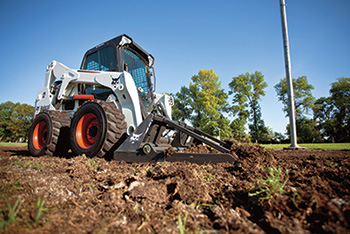Not too long ago, loader options started at shovel and ended at a very large loader, with little in between. Today, a vast selection of innovative skid-steer, all-wheel steer, mini track and compact track loaders can add efficiency and versatility to construction projects. Whether you’re planning a purchase or trying to match an existing machine to a particular project, there are several variables to consider.
For those unsure what those factors are or how to evaluate them, choosing the right loader can be challenging. Does it need to work well in tight construction sites? Does it need extra traction for pushing piles on soft or muddy ground? Will material be loaded onto a truck, requiring extra lift and reach? Will it be accessing gated areas or backfilling footings?
Answering these questions and achieving the best fit for an operation starts with an understanding of the primary types of loaders, as well as the features and attachments that can help tailor the machine to construction worksites and tasks. These five steps can help narrow down the choices.
1. Familiarize yourself with the different types of loaders
There are four different types of compact loaders, each designed to provide varying levels of power, lifting capacity and mobility for new construction, renovation and maintenance projects.

- Mini-track loader—This small, agile track loader can work in limited space with minimal ground disturbance. The size typically allows operators to walk behind or ride on the unit, and it is easy to load and transport on a trailer.
- Skid-steer loader—This loader type is differentiated by its type of steering. As the name implies, the tires on the left side work independently of those on the right side for greater maneuverability. This category also includes the all-wheel steer loader, which provides maximum turning radius.
- All-wheel steer loader—When working on projects that require minimal ground disturbance, an all-wheel steer loader may be your best choice. These loaders steer with all four tires. Some also have skid-steer capabilities to maximize versatility.
- Compact track loader—A loader with rubber tracks has good tractive effort and low ground pressure, which significantly increases mobility on soft, muddy and unpaved ground conditions.
2. Consider the typical worksite the loader will encounter
Due to their tires, skid-steer and all-wheel steer loaders have mobility and wear advantages on paved surfaces. This makes them the preferred choice for many demolition, renovation and snow removal applications.
Because compact track loaders have more area in contact with the surface, they can provide greater pushing and digging power.
A compact track loader will dig and load more material in the same amount of time, or the same amount of material in less time, due to superior traction capabilities.
In many parts of North America, a compact track loader will add months to the typical contractor’s working year because of its ability to float on wet, muddy ground.
3. Think through the lifting and digging capabilities needed
When it comes to lift arm design, most manufacturers offer a choice between loaders with a radius and vertical lift path.
- Radius-lift-path loaders raise the load in an arc that provides maximum reach at truck bed height. A radius-lift-path machine excels at jobs with mid-range working heights like dumping material over a wall, backfilling or loading and unloading flatbed trucks.
- Vertical-lift-path loaders provide higher lift capacity and more reach at full lift height than a radius-lift-path machine. Because maximum reach is achieved at full-lift height, it’s easier to clear high-sided trucks and hoppers.
If lifting and loading of high-sided trucks isn’t necessary, it is less expensive to purchase a radius-path machine. However, while vertical-path machines have a higher initial cost, they usually command higher prices at resale time. The other factor in lifting performance is rated operating capacity (ROC). Excavating and landscaping contractors generally need compact loaders with higher rated operating capacities because they move a lot of dirt, aggregate and other heavy loads. General contractors, on the other hand, may prefer a smaller, more versatile machine that can work in tight areas.
4. Compare the ownership costs
If most of your work is done in an existing development or on paved or improved surfaces, skid-steer loaders are the best choice. Not only do they have a lower initial cost for the same size machine, but they have lower ownership costs. While rubber tracks should last about twice as long as tires with proper operation, tires still cost considerably less.
- Tires—The average tire life is 600-800 hours in normal-use applications. Expect to pay between $600 and $1,200 for a set of tires depending on the type. Tire life can be prolonged in more abrasive conditions with severe-duty or solid rubber tires, which range from $3,200 to $3,600 per set. Their heavy-duty construction can reduce the cost-per-hour of ownership due to less frequent replacement cycles.
- Tracks—Rubber tire tracks for a like-sized loader range from $2,500 to $4,000 for a set. The average track life is between 1,200 and 1,600 hours for general-purpose, general-use machines on hard ground. The long-life end of the spectrum for loader tracks used mostly on soft dirt and soft clay can surpass 2,000 hours, where daily operation on hard pavement surfaces like asphalt or concrete may only provide useful life for 400 to 800 hours.
5. Evaluate anticipated utilization
Utilization is key with any compact loader because the more frequently you use it to fit your job applications and the more attachments you can put on it, the faster you realize a return on your investment. A key financial advantage of owning the three types of compact loaders is that with the purchase or rental of several different attachments, your business can build a higher utilization rate compared to operating and maintaining several different pieces of dedicated equipment.
